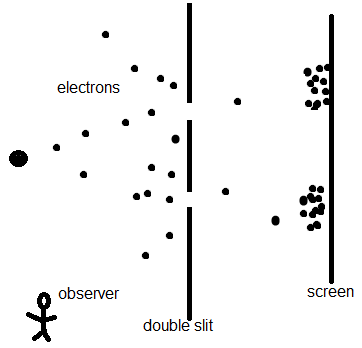
In a double slit experiment the angular width of a fringe is found to be 0.2° on a screen placed 1 m away. The wavelength of light used is 600 nm. The angular width of the fringe if entire experimental apparatus is immersed in water is (Take
Answer
519.9k+ views
Hint – To find the angular width of the fringe in water, we apply the formula of double slit experiment in both water and air medium, establish a relation between them using the given data and solve. The angular width when immersed in water is definitely different because the refractive index of air and water are different.
Formula Used:
Where θ is the angular fringe separation, λ is the wavelength of the incident light and d is the width of the slit.
Complete step-by-step solution -
Given Data,
Angular width of the fringe = 0.2°
Wavelength of light used = 600 nm
Refractive index of water,
We know Angular Fringe separation in air medium is given by
Let’s calculate when the apparatus is immersed in water,
The width of the slit ‘d’ is the same in air and in water. Let us consider the wavelength and the angular width of the fringe in water are
Hence here
As the distance d is the same, we equate them
Now we know refractive index of a medium is defined w.r.t the value of it in air medium, its formula is
Given
Hence Option A is the correct answer.
Note – In order to answer this type of question the key is to know the meaning and the relevant formulae of a double slit experiment. It was performed by Thomas Young in the 1800’s. Refractive index of a material is a dimensionless number that describes how fast light travels through the material, it does not have any units.

The double-slit experiment is a demonstration that light and matter can display characteristics of both classically defined waves and particles; moreover, it displays the fundamentally probabilistic nature of quantum mechanical phenomena.
Formula Used:
Where θ is the angular fringe separation, λ is the wavelength of the incident light and d is the width of the slit.
Complete step-by-step solution -
Given Data,
Angular width of the fringe = 0.2°
Wavelength of light used = 600 nm
Refractive index of water,
We know Angular Fringe separation in air medium is given by
Let’s calculate when the apparatus is immersed in water,
The width of the slit ‘d’ is the same in air and in water. Let us consider the wavelength and the angular width of the fringe in water are
Hence here
As the distance d is the same, we equate them
Now we know refractive index of a medium is defined w.r.t the value of it in air medium, its formula is
Given
Hence Option A is the correct answer.
Note – In order to answer this type of question the key is to know the meaning and the relevant formulae of a double slit experiment. It was performed by Thomas Young in the 1800’s. Refractive index of a material is a dimensionless number that describes how fast light travels through the material, it does not have any units.

The double-slit experiment is a demonstration that light and matter can display characteristics of both classically defined waves and particles; moreover, it displays the fundamentally probabilistic nature of quantum mechanical phenomena.
Latest Vedantu courses for you
Grade 11 Science PCM | CBSE | SCHOOL | English
CBSE (2025-26)
School Full course for CBSE students
₹41,848 per year
Recently Updated Pages
Basicity of sulphurous acid and sulphuric acid are

Master Class 12 Economics: Engaging Questions & Answers for Success

Master Class 12 Maths: Engaging Questions & Answers for Success

Master Class 12 Biology: Engaging Questions & Answers for Success

Master Class 12 Physics: Engaging Questions & Answers for Success

Master Class 4 Maths: Engaging Questions & Answers for Success

Trending doubts
Give 10 examples of unisexual and bisexual flowers

Draw a labelled sketch of the human eye class 12 physics CBSE

a Tabulate the differences in the characteristics of class 12 chemistry CBSE

Differentiate between homogeneous and heterogeneous class 12 chemistry CBSE

Why is the cell called the structural and functional class 12 biology CBSE

Differentiate between insitu conservation and exsitu class 12 biology CBSE




